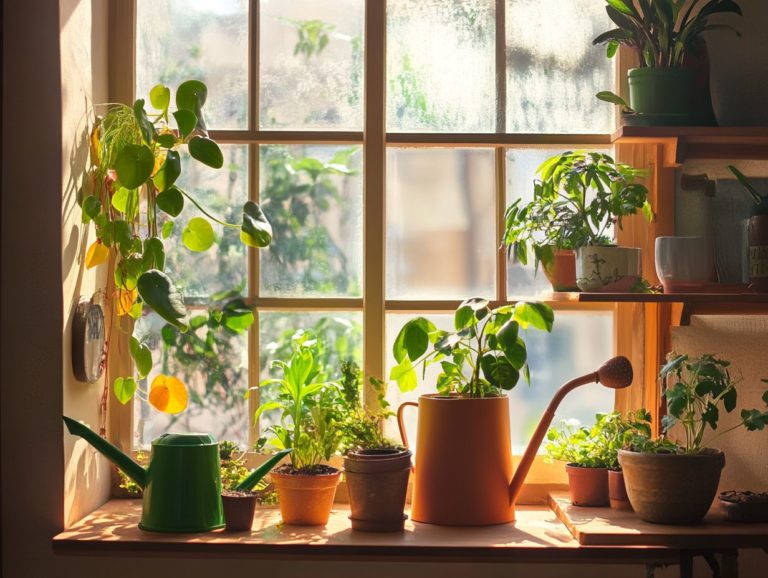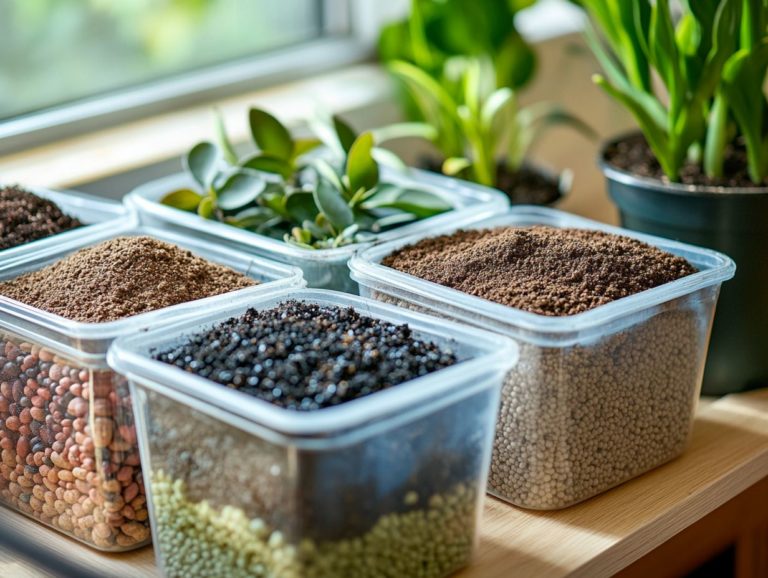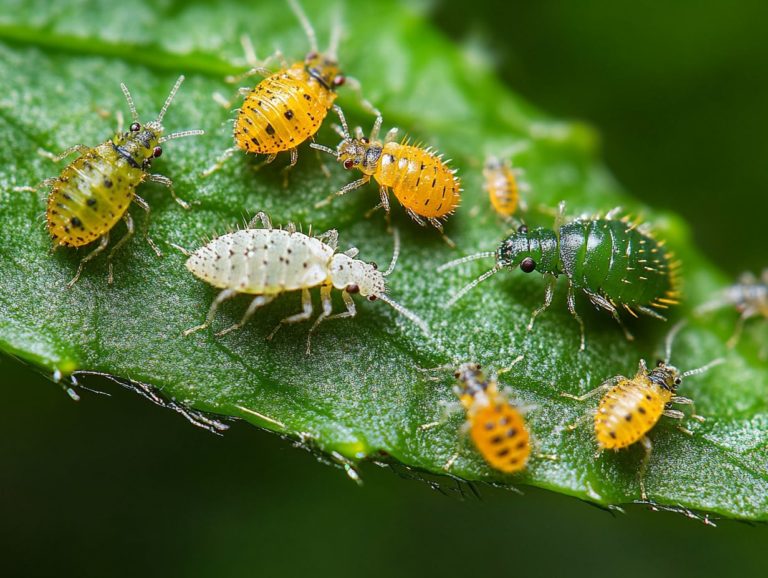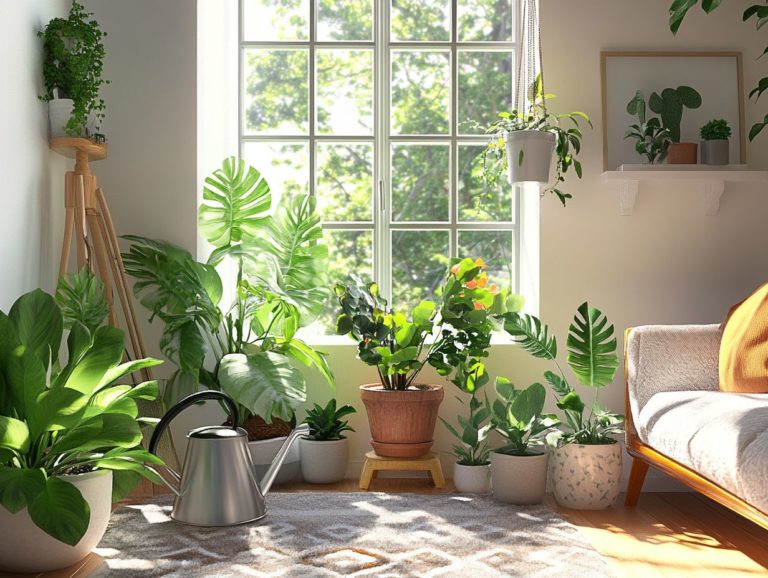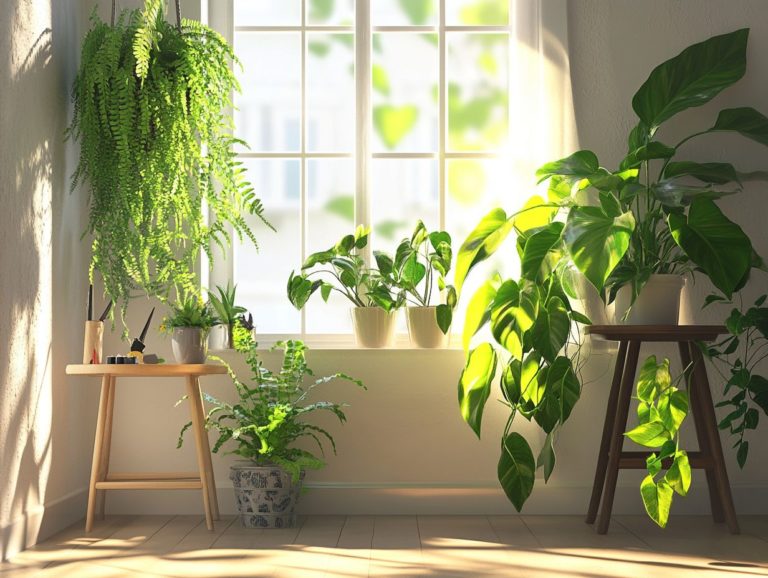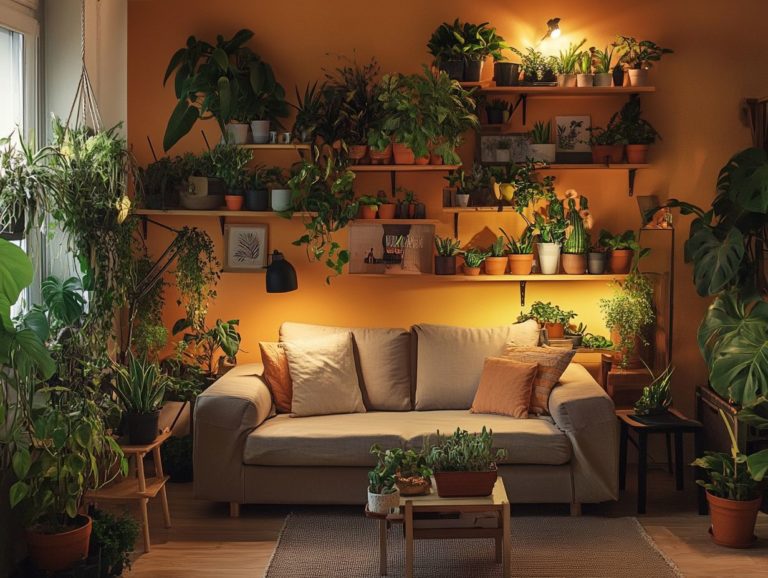What Fertilizer Should I Use for Indoor Plants?
Selecting the ideal fertilizer for your indoor plants can be a daunting task, given the many options available.
Understanding different fertilizers can be fun! Knowing their application methods and your plants’ unique requirements is essential for fostering robust growth. This guide explores the pros and cons of organic versus synthetic fertilizers, along with common pitfalls that may hinder your plants’ progress.
Whether you re a seasoned gardener or just starting out, you ll find valuable insights to help your indoor garden thrive.
Contents
Key Takeaways:

- Pick the right fertilizer for your plant’s unique needs today!
- Proper application techniques are crucial to avoid common mistakes like over-fertilization.
- Explore natural or DIY fertilizers for a more sustainable and cost-effective approach.
Understanding Indoor Plant Fertilizers
Understanding indoor plant fertilizers is essential for anyone eager to boost the growth and health of their houseplants. Think of fertilizers as the vital food your plants crave, delivering key nutrients like nitrogen, phosphorus, and potassium (NPK) that are crucial for their development.
You ll find various fertilizers both organic and synthetic each with its own application methods and effectiveness. Choosing the right fertilizer can mean the difference between a lush, thriving indoor garden and plants that struggle to grow.
By testing your soil and understanding your plants’ specific nutrient needs, plant care becomes manageable and rewarding.
Types of Fertilizers Available
When choosing fertilizers for your indoor plants, you’ll find options designed to meet the diverse needs of your houseplants, from organic choices to synthetic solutions. Organic fertilizers, such as Espoma Organic Indoor Plant Food and Neptune s Harvest, typically offer a balanced mix of nutrients while improving the soil’s health through the activity of tiny organisms. In contrast, synthetic fertilizers like Miracle-Gro and Osmocote provide concentrated formulations that yield quick results.
Understanding the characteristics of these fertilizers liquid, granules, or water-soluble is essential for effective plant care. Each type serves distinct purposes, allowing you to tailor your selections to different growth stages and plant varieties.
Liquid fertilizers, for example, are quickly absorbed and can rapidly nourish your plants, making them perfect for immediate needs, especially during the active growing season. Granular options, while slower to break down, offer a steady supply of nutrients over time, reducing how often you need to apply them.
As you explore indoor gardening, consider factors like application methods whether through foliar feeding or soil incorporation. User reviews can also help you determine which fertilizer aligns best with your gardening goals. By balancing these elements, you can cultivate a lush and thriving indoor garden.
Factors to Consider When Choosing a Fertilizer
Selecting the ideal fertilizer for your indoor plants requires careful attention to key factors, including plant type, nutrient requirements, soil quality, and pH balance.
Each houseplant species has its unique nutritional needs, guiding you to the most effective fertilizer for optimal growth. The quality of your soil is crucial for nutrient availability, and understanding its pH balance can greatly enhance your plants’ health.
Seasonal variations may also affect fertilizer application, so it’s important to adjust your feeding schedules accordingly. Through careful assessment and informed choices, you can ensure your plants receive the essential nutrients they need to flourish. Start nurturing your plants today!
Plant Type and Nutrient Needs
Different types of indoor plants, like cacti and flowering varieties, have unique nutrient needs that are essential for healthy growth. Understanding these requirements primarily nitrogen, phosphorus, and potassium (NPK) is crucial for effective feeding.
While cacti thrive in low-nutrient environments, flowering plants require a balanced approach to fertilization. This supports chlorophyll production and encourages robust blooms. Recognizing these differences helps you customize your fertilizer choices to enhance their overall health and vitality.
Cacti typically thrive on a diluted fertilizer that promotes root development and boosts drought resistance. In contrast, flowering plants flourish with a balanced formula that includes important small but significant nutrients like magnesium and iron, vital for vibrant blooms.
Regularly check the nutrient levels in your soil. Over-fertilization can lead to root burn or nutrient lockout, negatively affecting your plants health.
Follow a feeding schedule tailored to each plant s growth cycle. This customized approach ensures your indoor collection thrives beautifully.
Soil Quality and pH Balance

The quality of your soil and its pH balance are crucial for how effectively fertilizer works and the health of your indoor plants. Use well-aerated potting soil rich in organic materials to boost nutrient availability. Subpar soil quality can stifle growth.
Maintain an optimal pH balance. It directly impacts how your plants absorb vital nutrients and supports beneficial microbial activity in the soil. Regularly test soil quality and pH levels to create the ideal environment for your houseplants.
For most indoor plants, a balanced pH typically ranges between 6.0 and 7.0. Deviations can lock away essential nutrients like iron and magnesium. You can easily gauge soil pH with simple test kits available at garden centers or opt for laboratory testing for precise evaluation.
Incorporate compost or organic matter to naturally adjust soil acidity and enhance its structure. This improves drainage and aeration. Rotating your potting mix or adding amendments like lime can boost nutrient uptake, ensuring your indoor plants receive the nourishment they need.
How to Apply Fertilizer to Indoor Plants
Applying fertilizer to your indoor plants is crucial for unlocking their growth potential. Ensure essential nutrients reach the roots. You have several methods at your disposal, such as:
- Mixing fertilizer into potting soil
- Utilizing water-soluble formulations during your regular watering routine
- Incorporating granular fertilizers for a slow-release effect
The effectiveness of each method varies with the seasons. During the growing season, your plants generally benefit from more frequent feedings. In periods of dormancy, cut back on applications.
By following best practices and testing recommendations, you can ensure your indoor plants receive the nutrients they need. To further enhance their growth, it’s crucial to understand what soil is best for indoor plants and avoid the pitfalls of over-fertilization.
Proper Techniques and Frequency
Implementing the right techniques and frequency for fertilizing your indoor plants is essential for achieving optimal growth and health. Understanding how often to feed your plants can vary based on several factors, such as the type of plant and its growth stage.
The fertilizer being used also plays a crucial role. Customize your fertilization strategy for the best results! For instance, flowering plants often require more frequent nutrition during their blooming stage. Meanwhile, foliage plants benefit from a balanced feeding schedule.
Pay close attention to signs of nutrient deficiency, as they provide valuable guidance for adjusting your regimen. Regarding watering and fertilization, it’s best to apply liquid fertilizer during a watering session. This method helps dissolve the nutrients, making them readily available for uptake.
Not only does this maximize nutrient efficiency, but it also minimizes the risk of over-fertilization. Being mindful of seasonal changes can further enhance your plants’ vitality, ensuring they receive the right nutrients precisely when they need them.
Common Mistakes to Avoid
Avoiding common mistakes in indoor plant fertilization is crucial for maintaining the health of your plants and avoiding problems like over-fertilization. One frequent pitfall is applying too much fertilizer, which can cause nutrient burn damage to plants caused by excessive fertilizer or invite pests that thrive on the excess nutrients.
Familiarizing yourself with the signs of over-fertilization such as wilting leaves and stunted growth will enable you to adjust your approach swiftly. Recognizing the specific needs of different plant types will ensure you administer the right balance of nutrients, enhancing their effectiveness and overall health.
Over-fertilization and Other Pitfalls
Over-fertilization is a pitfall you want to avoid when caring for your indoor plants, as it can lead to a host of problems, from nutrient burn to unwelcome pest infestations. When you introduce too many nutrients into the soil, you disrupt the plant’s natural balance, making it harder for the plant to absorb the essentials it needs.
You might notice yellowing leaves, wilting, or, in the worst-case scenario, a dead plant. Excess nutrients can also attract pests like aphids and mealybugs, turning your plant care routine into a juggling act.
By understanding the signs of over-fertilization and adjusting your application methods, you can mitigate these risks and promote healthier growth. Recognizing symptoms early is crucial; keep an eye out for curling leaves, dropping foliage, or an overly lush appearance that signals trouble.
Act quickly if you notice these issues! This might involve flushing the soil with water to dilute the excess fertilizer or repotting your plant with fresh, nutrient-balanced soil, which is soil that contains the right amount of nutrients for healthy plant growth.
Maintaining a balanced nutrient approach is vital for optimal plant health. It s wise to follow package instructions meticulously, conduct soil tests, and consider organic amendments that release nutrients slowly. Developing a feeding schedule tailored to your plant’s specific needs can help you avoid over-application and foster strong, vibrant growth.
Organic vs. Synthetic Fertilizers
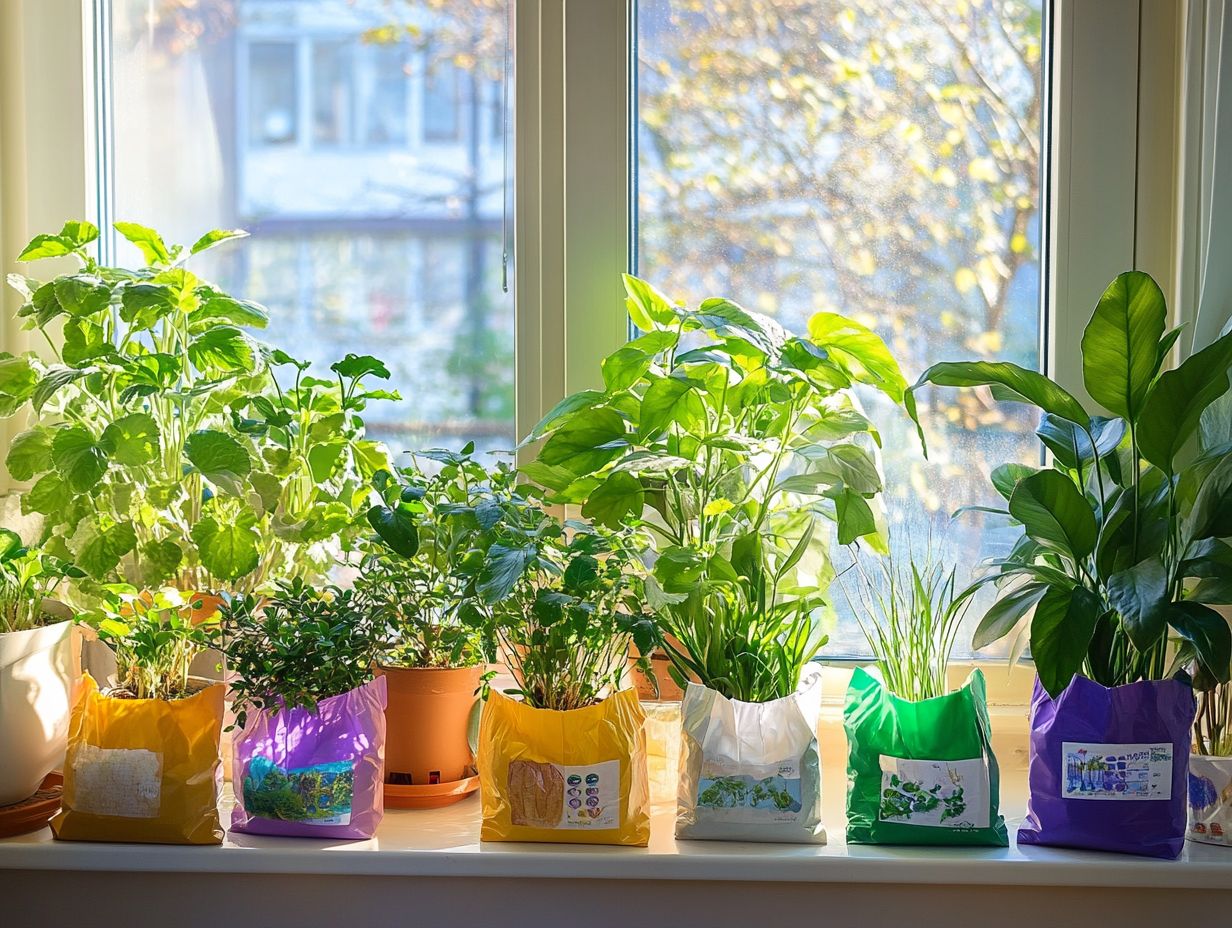
The debate surrounding organic versus synthetic fertilizers is ever-present, with each option offering unique advantages and drawbacks for your indoor plant care.
Organic fertilizers, derived from compost or natural materials, enrich soil health by nurturing beneficial microbes. They ensure a slow release of nutrients, promoting a more sustainable growing environment for your plants.
On the other hand, synthetic fertilizers deliver concentrated nutrients that yield rapid results, making them particularly attractive if you seek immediate effects.
By grasping the pros and cons of both options, you can make informed choices that resonate with your gardening philosophy and cater to your houseplants’ specific needs.
Pros and Cons of Each Type
Both organic and synthetic fertilizers have advantages and disadvantages that significantly impact your indoor plant care and overall plant health.
Organic fertilizers often enhance soil structure and introduce beneficial microbes. This boosts the long-term vitality of your growing medium. However, they may require more frequent applications and can take longer to show results.
Synthetic fertilizers provide immediate nutrient availability, allowing for rapid growth and healthy blooms. But be cautious overusing them can lead to soil degradation.
Evaluate these factors to choose the best fertilizer for your plants. Organic options often contain various nutrients that release slowly over time, maintaining a consistent nutrient supply. This gradual release also reduces nutrient loss into water systems, benefiting both your plants and the environment.
In contrast, synthetic fertilizers can contribute to nutrient runoff, which harms local ecosystems. As you navigate these choices, consider balancing your plants’ immediate needs with long-term soil health to align with your ethical beliefs and cultivation goals.
Alternatives to Traditional Fertilizers
Explore exciting alternatives to traditional fertilizers for healthier indoor plants, promoting sustainability and enhancing plant health.
Consider natural and DIY options like compost, worm castings, and kitchen scraps. These nutrient-rich alternatives can significantly improve soil quality and boost microbial activity.
By embracing these methods, you lessen your dependence on commercial fertilizers while enriching your growing media with essential nutrients organically.
Try these options now and uncover amazing strategies to boost your plants’ health while minimizing your environmental footprint.
Natural and DIY Options
Natural and DIY options for fertilizing indoor plants have surged in popularity as you seek sustainable and effective alternatives to commercial fertilizers.
Explore a range of nutrient sources tailored specifically to your plants’ unique needs. For example, crushed eggshells are rich in calcium, vital for promoting strong cell formation. Epsom salt provides magnesium, which aids photosynthesis and enhances blossom health.
Incorporating fish emulsion or seaweed extract into your routine introduces trace minerals and encourages growth without relying on harsh chemicals. These natural fertilizers nourish your plants, promoting vibrant foliage and stunning blooms that elevate your living spaces.
It’s a win-win for both your plants’ vitality and your environmental consciousness.
Frequently Asked Questions
What Fertilizer Should I Use for Indoor Plants?
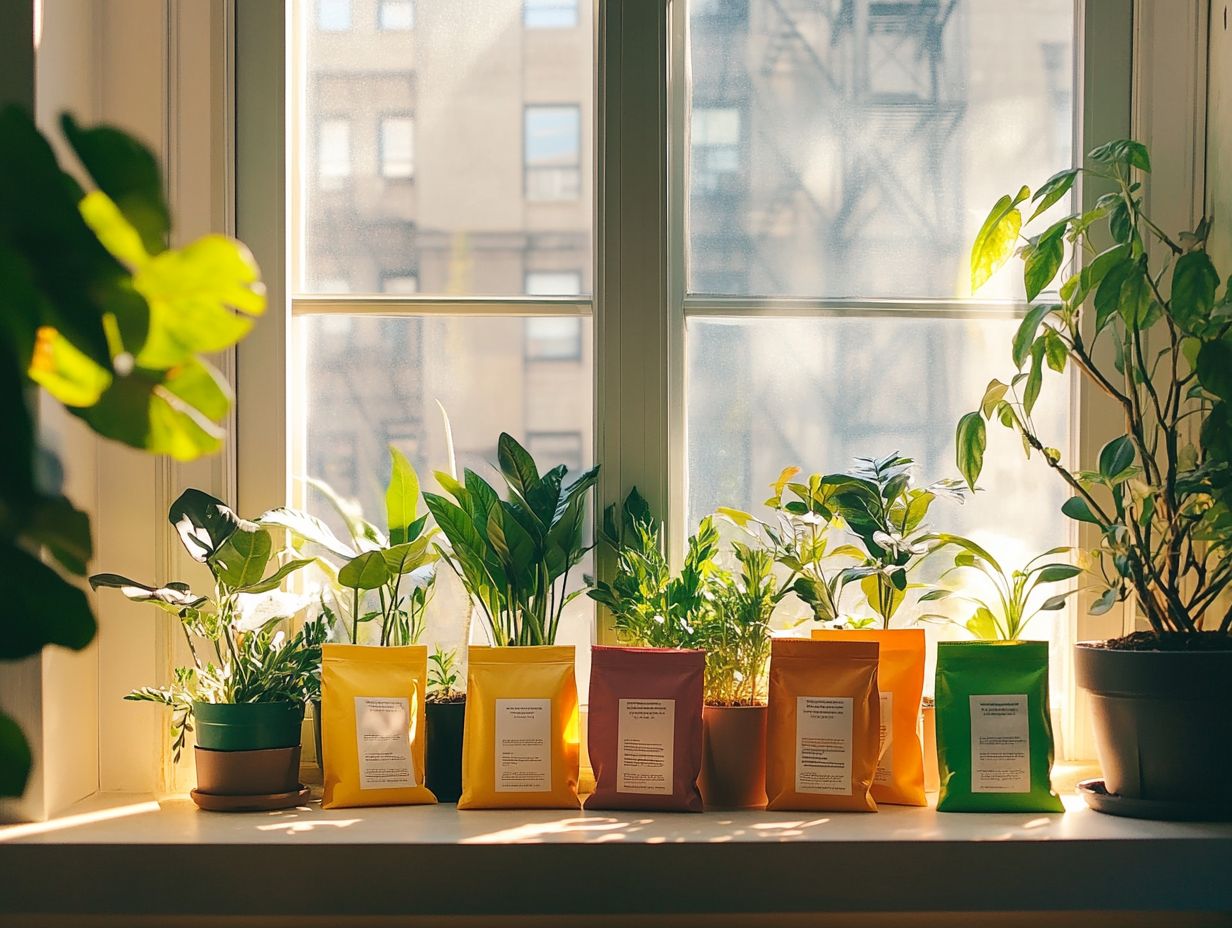
The best fertilizer for indoor plants is one specifically formulated for them. Look for fertilizers labeled as “indoor plant fertilizer” or “houseplant fertilizer.”
Can I use outdoor plant fertilizer on my indoor plants?
Using outdoor fertilizers on indoor plants is not recommended. Outdoor fertilizers may have higher concentrations of nutrients that can burn or damage delicate indoor plants.
Are organic fertilizers better for indoor plants?
Organic fertilizers can be a good option for indoor plants as they release nutrients slowly and are gentler on them. However, choose an organic fertilizer specifically made for indoor plants.
How often should I fertilize my indoor plants?
This depends on the type of indoor plant and the fertilizer you use. Generally, fertilize once a month during the growing season and stop during winter when plants are not actively growing.
Try these tips, and share your results!
Can I make my own fertilizer for indoor plants?
Absolutely! You can create your own fertilizer using natural ingredients like compost, banana peels, or eggshells.
Just make sure to research the right mix to provide your plants with the nutrients they need.
How much fertilizer should I use for my indoor plants?
Always follow the instructions on the fertilizer packaging for the correct amount.
If you’re unsure, it’s best to start with a smaller dose. You can also reach out to a gardening expert or look online for tips specific to your plants.

